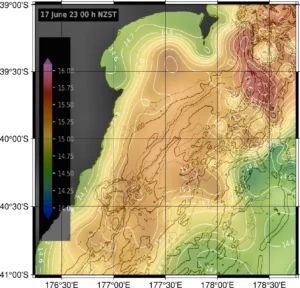How do albacore tuna use fronts?
In a nutshell
- Temperature fronts generally have a cooler side and a warmer side.
- There tends to be more feed in the deeper cold water where there are more nutrients.
- Albacore move along the fronts, crossing back and forth between the warm and cool sides.
- During the day, they feed in the deep water on the cold side of the front, and then move back into the surface water on the warm side of the front to allow their muscles to warm up.
- Trolling in a zig-zag across the front should increase chances of encountering the tuna.
- Trolling on just the cool side of the front would reduce encounter rate with tuna.

Details
Studies with tagged albacore off the coast of Baja California revealed that fronts enhance the foraging success of albacore. This means that albacore feed more successfully when they are near areas with stronger temperature breaks.
Temperature breaks or fronts can be grouped into two types. Mesoscale fronts are longer (10-100 km), last for weeks to months, and tend to reappear seasonally. An along-front jet, or current, is often associated with these fronts. Sub-mesoscale fronts are more ephemeral (they come and go), and smaller (1 to 10 km). They produce vertical and horizontal currents that transport nutrients into the surface waters, leading to accumulations of phytoplankton and zooplankton.
Albacore exploit these variable sub-mesoscale fronts, working across the horizontal and vertical frontal gradients. The reason they do this is that these fish benefit by feeding more effectively in the frontal zones. Their feeding success is greater where the temperature gradients are steepest. The steepness of the temperature gradient, or the strength of the temperature break can weaken or strengthen over periods from days to a week or more.
During the night, the fish spend most of their time in the surface waters on the warm side of the front. Plankton, krill, and squid migrate into the surface waters each night, and descend again to the depths during the day. In the daytime, albacore benefit by swimming across the front and diving into the cold deep water on the cool side of the front to feed. There generally tends to be higher concentrations of feed in the cold deep water because higher concentrations of nutrients are found there. The albacore then return to the surface waters on the warm side of the front to warm their muscles, swim faster, and increase the clarity of their vision, all of which gives them an advantage over their prey. They also increase their digestive efficiency in the warm water.
Albacore can make as many as 80 trips across a temperature break in a day, because this behaviour increases their feeding efficiency. The tagging studies provided a window into the behaviour of the fish allowing us to discover why these tuna are often found in areas with temperature fronts.
